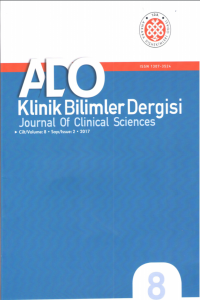Farklı Akademik Dönemlerdeki Diş Hekimlığı Öğrencilerin Öğrenme Koşulları İle İlgili Tercihleri
diş hekimliği eğitimi, protetik diş tedavisi, öğrenci tercihleri, öğretim
The Preferences of Dentistry Students in Different Academic Period On Learning Conditions
dental education, prosthodontics, student preferences, teaching,
___
- 1) Miller P. Learning styles the multimedia of the mind. Educational Resources Information Center ED 451 140, 2001.
- 2) Murphy RJ, Gray SA, Straja SR, and Bogert MC. Student learning preferences and teaching implications. J Dent Educ 2004; 68(8): 859–866.
- 3) Lujan HL, Dicarlo SE. First-year medical students prefer multiple learning styles. Advances in Physiology Education 2006; 30(1): 13–16.
- 4) Aleamoni LM. Student rating myths versus research facts from 1924 to 1998. J Personnel Eval Educ 1999;13(2): 153–66.
- 5) Jahangiri L, Mucciolo TW, Choi M, Spielman AI. Assessment of teaching effectiveness in U.S. dental schools and the value of triangulation. J Dent Educ 2008;72(6): 707-18
- 6) Henzi D, Davis E, Jasinevicius R, et al. Appraisal of the Dental School Learning Environment: The Students’ View J Dent Educ 2005; 69(10); 1137-47
- 7) Asiry MA. Learning styles of dental students. The Saudi Journal for Dental Research 2016;7(1); 13-17
- 8) Sikora, D. What great teachers do (or should do): innovative brain-based instructional strategies.Athttps://www.thefreelibrary.com/What+great+teachers+do+(or+should+do)%3A+innovative+brain-based...-a0345613798, 2013.
- 9) Eze C, Edward OM. Lecture duration: A risk factor for quality teaching and learning in Higher Education. Integrity Journal of Education and Training 2017;1(1): 1-5.
- 10) Parolia A, Mohan M, Kundabala M, Shenoy R. Indian Dental Students’ Preferences Regarding Lecture Courses. J Dent Educ 2012;76(3): 366-71.
- 11) Biggers JL. Body Rhythms, the School Day, and Academic Achievement. Journal of Experimental Education 1980;49(1);45-47.
- 12) Ammons TL, Booker Jr JL, Killmon CP. The Effects of Time of Day on Student Attention and Achievement. Reports Research/Technical 1995;143: 66p.
- 13) Susskind JE. PowerPoints power in the classroom: enhancing students’ self-efficacy and attitudes. Computers & Education 2005;45; 203–15.
- 14) Szaboa A, Hastings N. Using IT in the undergraduate classroom: should were place the blackboard with PowerPoint? Computers & Education 2000;35: 175-87.
- 15) Kiewra KA. A Review of Notetaking: The Encoding-Storage Paradigm and Beyond. Educational Psychology Review June 1989; 1(2): 147-172.
- 16) Chen J, Lin T-F. Does downloading PowerPoint slides before the lecture lead to better student achievement? International Review of Economics Education 2008;7(2): 9–18.
- 17) Babb KA, Ross C. (2009). The timing of online lecture slide availability and its effect on attendance, participation, and exam performance. Computers & Education 2009;52; 868–81.
- 18) Hayward, Jennifer M. The Effects of Homework on Student Achievement. Education and Human Development Master's Theses. 2010.
- 19) Deveci T. Homework vs. Home-learning: A Lifelong Learning Perspective and Student Perceptions. ESBB 2019;5(1): 57-80.
- 20) Perrin RW, Laing GK. The lecture: a teaching strategy through the looking glass. The E-Journal of Business Education & Scholarship of Teaching 2014;8(1): 67-77.
- 21) Scouller K. The Influence of Assessment Method on Students' Learning Approaches: Multiple Choice Question Examination versus Assignment Essay Higher Education 1998;35(4): 453-472. (Paper presented at the Annual Conference of the Australian Association for Research in Education, Sydney, 4-7 December 2000).
- 22) Theophilides C, Koutselini M. Study Behavior in the Closed Book and the Open Book Examination A Comparative Analysis Educational Research and Evaluation 2000;6(4): 379-393.
- 23) Anaya L, Evangelopoulos N, Lawani U. AC 2010-2137: Open-book vs. closed-book testing: an experimental comparison. American Society for Engineering Education 2010.
- 24) Halperin N. The impact of attendance and student characteristics on academic achievement: findings from an undergraduate business management module Journal of Further and Higher Education 2007:31(4): 335–349.
- 25) Devadoss S, Foltz JC. Evaluation of Factors Influencing Student Class Attendance and Performance. American Journal of Agricultural Economics, 1996;78, 499- 507.
- 26) Stanca L. The effects of attendance on academic performance: panel data evidence for Introductory Microeconomics. Working Paper Series No. 78, 2004.
- 27) Volkov A, Volkov M. Computer-Mediated Education: The Relationship between Computer Access, Tutorial Attendance and Student Grades. e-Journal of Business Education & Scholarship of Teaching 2009;3(1): 18-24.
- 28) Zitzmann NU, Matthisson L, Ohla H, Joda T. Digital Undergraduate Education in Dentistry: A Systematic Review. Int. J. Environ. Res. Public Health 2020;17; 3269.
- 29) Towers A, Field, J, Stokes C, et al. A scoping review of the use and application of virtual reality in pre-clinical dental education. Br. Dent. J. 2019;226(5):358–366.
- 30) Alexander CD, Bayer H, Brownson AB, et al. Southwest Educational Development Laboratory. Resource allocation practices and student achievement: An examination of district expenditures by performance level with interviews from twenty-one school districts. Austin, TX, 2000; 1-52.
- ISSN: 1307-3540
- Yayın Aralığı: Yılda 3 Sayı
- Başlangıç: 2006
- Yayıncı: Ankara Diş Hekimleri Odası
ALT ÜÇÜNCÜ MOLAR DİŞLERİN ALT İKİNCİ MOLAR VE ALT KANİN DİŞLERİNİN EKSEN EĞİMLERİNE OLAN ETKİSİ
Bozkurt Kubilay IŞIK, Ahmet Ertan SOĞANCI, Arif Yiğit GÜLER, Dilek MENZİLETOĞLU
Farklı Akademik Dönemlerdeki Diş Hekimlığı Öğrencilerin Öğrenme Koşulları İle İlgili Tercihleri
OLGU SUNUMU: EHLERS- DANLOS SENDROMUNA SAHİP İSKELETSEL SINIF III PATERNE SAHİP HASTANIN TEDAVİSİ
Tuğçe TANIR ERTUNÇ, Gül Nihan TALAY, Elif DEĞİRMENCİ, Öykü ÖZEN, Dilek ERDEM
Gömülü Kanin Varlığı ile Maksiller Diş Boyutları Arasındaki İlişkinin Değerlendirilmesi
Ezgi SUNAL AKTÜRK, Elif KOÇ, Fatma DERİN, Berza SEN YİLMAZ
MANDİBULANIN PATOLOJİK KIRIK NEDENLERİ VE KRİTİK BOYUT DEFEKTİ KAVRAMI
Diş Hekimliği Öğrencilerinin İngilizce Öz Yeterlik Algısı ve İngilizce Bilgi Düzeyi İlişkisi
Didem ÖZKAL EMİNOĞLU, Tuğba AYDIN, Didar Betül DOĞAN
Özgür İlke ULUSOY, İlke Gaye SAVUR, Arzu ŞAHİN MANTI
Gökçen AKÇİÇEK, Şevket Murat ÖZBEK, Hatice Yağmur ZENGİN
Sağ Maksiller Sinüste Gelişim Gösteren Radiküler Kist: Vaka Raporu
